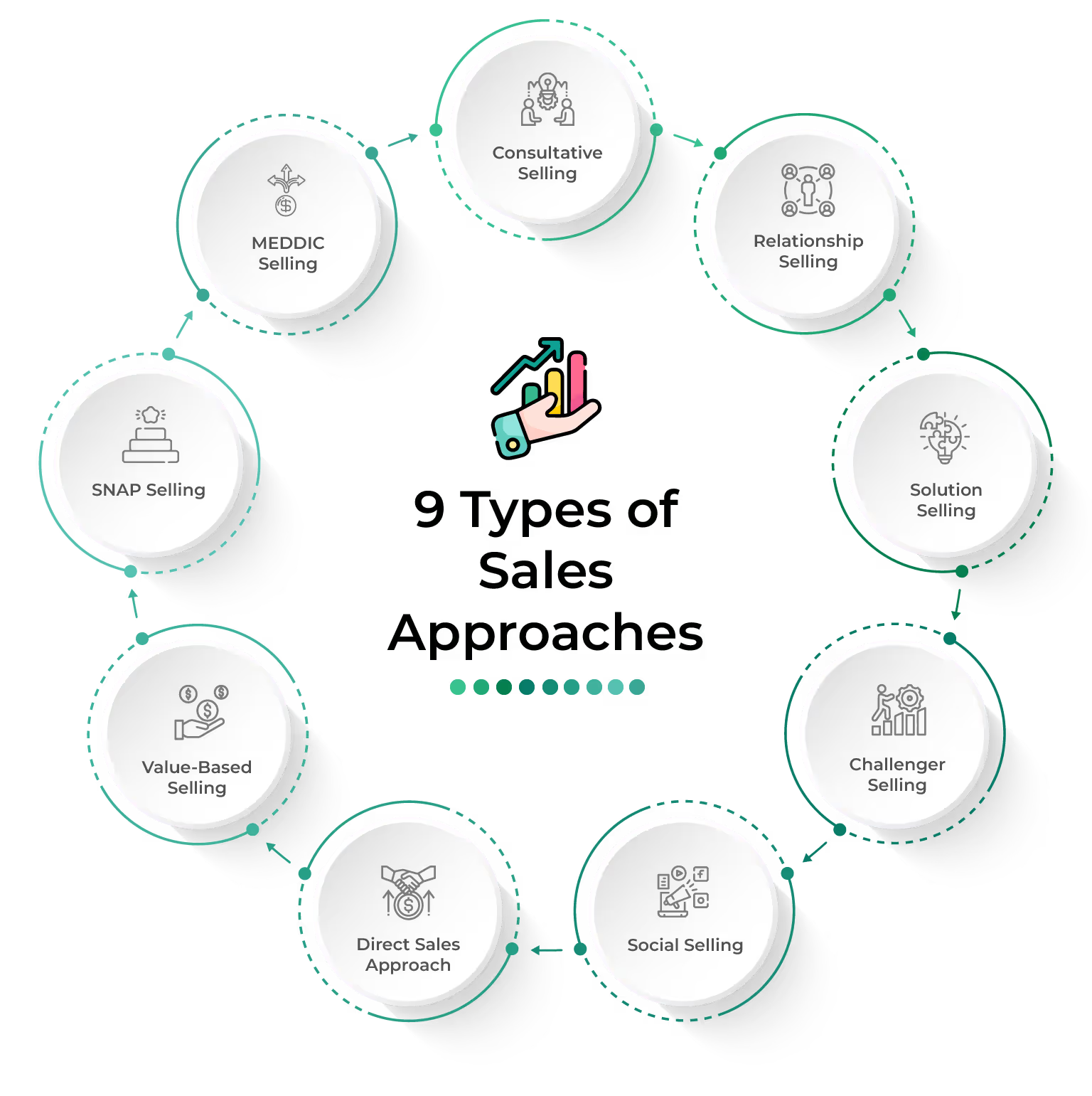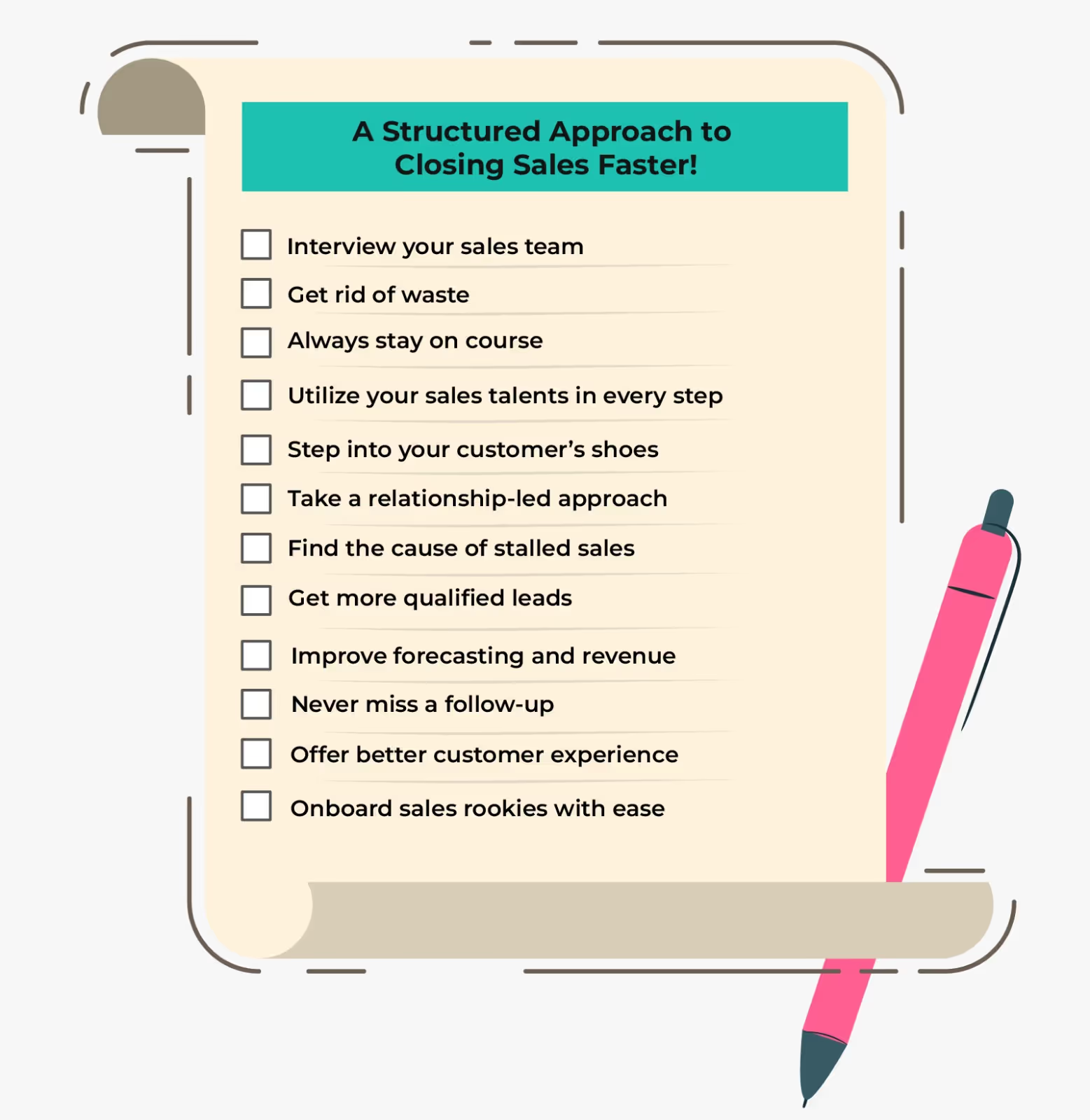
Blog
Why Sales Approaches Are the Key to Your Business Success
September 15, 2023


Key Insights
Sales are the lifeblood of any business. Without a steady stream of revenue, even the most innovative products or services can struggle to survive in today's competitive market.
To thrive, organizations need to continuously refine their sales strategies and adapt to changing customer behaviors.
In this blog, we will explore some effective sales approaches that can help you boost your revenue and close more deals.
What is a Sales Approach?

A sales approach refers to the strategy or method that a salesperson or a sales team uses to engage with potential customers, build relationships, and ultimately persuade them to make a purchase.
It encompasses the overall plan and tactics that guide the sales process from prospecting and initial contact through to closing the deal and maintaining customer satisfaction.
A well-defined sales approach, such as the MEDDIC sales process, helps sales professionals navigate the complex and competitive world of sales by providing structure and direction to their efforts.
9 Types of Sales Approaches:

There are various sales approaches that sales professionals and organizations can use to effectively engage with potential B2B prospects and increase their chances of closing deals.
The choice of approach often depends on the nature of the product or service, the target audience, and the specific industry.
Here are some common types of sales approaches to consider:
1. Consultative Selling:
Consultative selling is a customer-centric approach that focuses on understanding the customer's pain points and providing solutions to their specific problems.
Instead of bombarding prospects with product features, consultative salespeople ask probing questions to uncover the client's needs and offer tailored solutions. This approach builds trust and helps establish long-term relationships with customers.
Key elements of consultative selling include active listening, empathy, a deep understanding of your product or service's capabilities, and leveraging sales data analysis to identify tailored solutions that precisely meet your client's needs. By becoming a trusted advisor, you can position yourself as the go-to resource for your clients.
2. Relationship Selling:
Relationship selling emphasizes building strong, long-term relationships with customers.
The primary goal is not just to make a sale but to create loyal customers who will return and refer others.
Relationship selling involves nurturing connections through regular communication, providing exceptional customer service, and showing genuine interest in the customer's success.
To excel in relationship selling, focus on building rapport, maintaining a client database, and consistently delivering on promises. Over time, these efforts can lead to a network of loyal clients who are more likely to do business with you.

3. Solution Selling:
Solution selling is about presenting your product or service as a solution to a specific problem your customer is facing.
This approach requires a deep understanding of the customer's pain points and a clear articulation of how your offering can address those challenges. It often involves customized presentations and proposals tailored to each prospect.
To master solution selling, hone your problem-solving skills, product knowledge, and the ability to connect the dots between your offering and the customer's needs. Be prepared to demonstrate the tangible benefits and ROI your solution can provide.
4. Challenger Selling:
Challenger selling is a proactive approach that challenges the prospect's current way of thinking or doing business.
Instead of merely responding to customer inquiries, challenger salespeople actively educate their prospects about new opportunities, often by introducing them to unconsidered needs or solutions.
This approach requires a deep understanding of the customer's industry and a willingness to challenge the status quo.
To employ challenger selling effectively, conduct thorough research on your prospects, industry trends, and competitors. Develop a compelling narrative that challenges the customer's assumptions, strategically incorporating sales positioning, and positions your solution as a game-changer.
5. Social Selling:
In the digital age, social selling leverages social media platforms and online networks to connect with prospects and build relationships.
It involves sharing valuable content, engaging in meaningful conversations, and establishing yourself as an industry expert. Social selling allows you to reach a broader audience and nurture relationships at scale.
To succeed in social selling, maintain an active online presence, create and share relevant content, and engage with your audience regularly. Utilize social media platforms, such as LinkedIn, Twitter, and Instagram, to connect with prospects and share insights. Additionally, monitor your Instagram call history to track interactions and follow up with potential leads effectively.
6. Direct Sales Approach:
Direct sales involve a straightforward, assertive approach where salespeople focus on highlighting the product's features and benefits. This approach is typically used for products with clear and immediate value propositions.
While it may not involve as much personalization as consultative or solution selling, it can be effective for customers looking for a quick and efficient buying experience.
7. Value-Based Selling:
Value-based selling revolves around demonstrating the value that the product or service brings to the customer's business.
It involves showcasing how the purchase will result in tangible benefits, such as cost savings, increased revenue, or improved efficiency.
Sales professionals employing this approach use data and metrics to quantify the value proposition, making it an effective choice for customers who prioritize ROI and a crucial element of effective B2B sales strategies.
8. SNAP Selling:
SNAP stands for "Simple," "iNvaluable," "Aligned," and "Priority." This approach is designed to help sales professionals engage effectively with modern, busy, and often overwhelmed buyers.
Here's an overview of each component of the SNAP selling approach:
- Simple: Keep your sales message simple and concise.
- iNvaluable: Shift the focus from your product or service's features to the value it provides to the customer.
- Aligned: Ensure that your sales approach is aligned with the buyer's needs, goals, and priorities.
- Priority: Recognize that buyers have limited time and resources, and they often prioritize the most urgent and critical issues.
Incorporating the SNAP selling approach into your sales strategy can help you connect more effectively with potential customers, create a stronger value proposition, and increase your chances of closing deals.
It's especially useful in situations where buyers are inundated with information and need a straightforward, value-focused solution to their challenges.
9. MEDDIC Selling:
The acronym MEDDIC stands for Metrics, Economic Buyer, Decision Criteria, Decision Process, Identify Pain, and Champion.
Here's an overview of each component of the MEDDIC approach:
- Metrics: Understanding the key performance indicators (KPIs) and metrics that matter most to the prospect or customer.
- Economic Buyer: Identifying and engaging with the person or group within the organization who has the authority to make purchasing decisions.
- Decision Criteria: Determining the specific criteria and factors that the prospect will use to evaluate and make a decision.
- Decision Process: Mapping out the steps and stages involved in the prospect's decision-making process.
- Identify Pain: Uncovering the prospect's pain points or challenges that your product or solution can address.
- Champion: Finding and cultivating a champion within the prospect's organization.
The MEDDIC approach is a structured way of qualifying leads and opportunities in the sales process.
It helps sales professionals (both sales associates vs sales executives) focus their efforts on deals that are more likely to close successfully and ensure that they have a deep understanding of the prospect's needs and buying process, fostering effective sales collaboration examples.
When applying the MEDDIC approach, salespeople typically use a checklist or framework to assess and score opportunities, which helps them prioritize their time and resources on high-potential deals.
This methodology can be particularly effective in complex B2B sales environments where multiple stakeholders are involved, and the sales cycle is lengthy.
Over the years, MEDDIC has evolved to become MEDDICC and MEDDPICC sales methodology.
A Structured Approach to Closing Sales Faster!
Close deals faster and smoother than ever before. Here's a super easy system to follow that keeps you on top of your game and never lets a hot lead slip away:

Interview your sales team-
Regular chats with your team help you understand their challenges and what's working.
Get rid of waste:
Stop wasting time on unqualified leads or dead-end pitches. Streamline your process to focus on high-potential customers. Think of it like decluttering your sales funnel.
Always stay on course:
Sales can get messy. Having a clear sales process keeps everyone focused and avoids confusion.
Utilize your sales talents in every step:
Make sure to let great salespeople spend their charm on paperwork! Play to their strengths throughout the process for maximum impact.
Step into your customer’s shoes:
See things from their perspective. What are their needs and pain points?
Take a relationship-led approach:
People buy from people they like and trust. Build genuine connections with your customers, not just transactions.
Find the cause of stalled sales:
Is it bad leads, unclear presentations, or something else? Identify the bottlenecks and fix them.
Get more qualified leads:
Focus on attracting the right kind of customers who are a good fit for what you offer.
Improve forecasting and revenue:
A structured process helps predict future sales and plan accordingly.
Never miss a follow-up:
Don't leave customers hanging! Stay in touch and answer their questions.
Offer better customer experience:
Make the buying process smooth and enjoyable. Happy customers lead to more sales!
Onboard sales rookies with ease:
Make it easy for new salespeople to learn the ropes.
In summary, a thorough salesforce process evaluation and a well-defined sales approach are useful because they provide a structured framework for sales professionals to engage with potential customers, build relationships, and guide them through the buying process.
It helps sales teams work more efficiently and effectively, increasing their chances of closing deals and achieving their sales targets. Additionally, it ensures a customer-centric approach, which is essential in today's competitive business landscape, by delineating clear sales team roles and responsibilities.
ReKennect : Stay ahead of the curve!
Subscribe to our bi-weekly newsletter packed with latest trends and insights on incentives.
Thank you! Your submission has been received!
Oops! Something went wrong while submitting the form.
Your data is in safe hands. Check out our Privacy policy for more info














